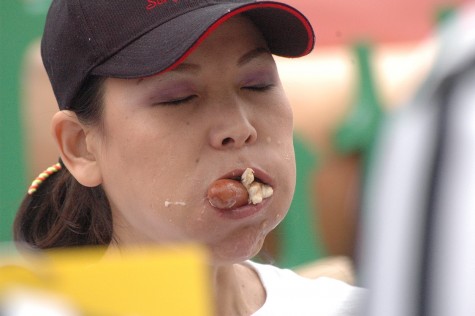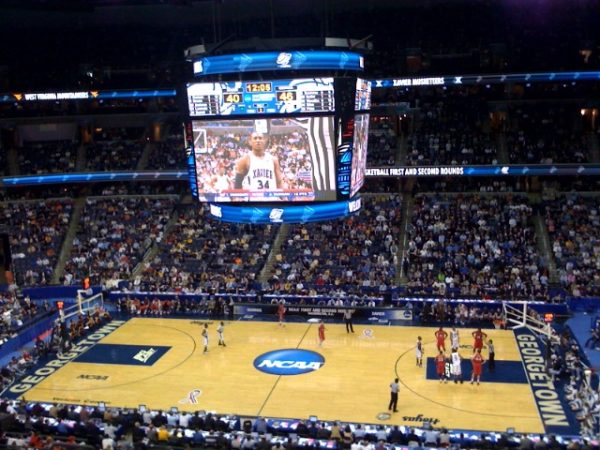Food for Thought
 On February 6, the Krispy Kreme Challenge took place in West Raleigh, North Carolina, an event that takes place annually to benefit the North Carolina Children’s Hospital by giving ten percent of the yearly donations. More than eight thousand runners gathered this year to begin their race at North Carolina University at Chapel Hill, specifically at Memorial Belltower. Participants ran two and a half miles, through downtown Raleigh, and to the Krispy Kreme near by. Once they reached the location, they had to consume twelve original glazed doughnuts, and run back to the belltower in under an hour. Downing all that sugar before aggressive exercise can be a real challenge for a lot of athletes; even the motto for the event is “2400 calories, 12 doughnuts, 5 miles, 1 hour.”
On February 6, the Krispy Kreme Challenge took place in West Raleigh, North Carolina, an event that takes place annually to benefit the North Carolina Children’s Hospital by giving ten percent of the yearly donations. More than eight thousand runners gathered this year to begin their race at North Carolina University at Chapel Hill, specifically at Memorial Belltower. Participants ran two and a half miles, through downtown Raleigh, and to the Krispy Kreme near by. Once they reached the location, they had to consume twelve original glazed doughnuts, and run back to the belltower in under an hour. Downing all that sugar before aggressive exercise can be a real challenge for a lot of athletes; even the motto for the event is “2400 calories, 12 doughnuts, 5 miles, 1 hour.”
This year was the twelfth annual Krispy Kreme Challenge. However, the race ended with the death of a fifty-eight year old man who started feeling chest pains during the first mile of the race and then stopped and left the track. He was then driven by EMS to Rex Hospital close by, and passed away there. On Twitter, the doughnut shop expressed their sorrows for what happened saying, “ We are deeply saddened and wish to convey our heartfelt condolences to his loved ones.” Wilcox freshman, Emily Cameron, was frightened about this, saying, “Although the Krispy Kreme Challenge may sound like fun, it also poses a lot of dangers, with the most concerning incident was a man dying. I wouldn’t want to risk my life to eat a dozen doughnuts.”*
According to Wikipedia, competitive eating (also called speed eating) is “A sport in which participants compete against each other to consume large quantities of food in a short time period.” To others it seems like a funny contest to watch for a few giggles, and to make fun of the people with stuffed full faces. However, those people do not realize what the role of the sport is in the athletic world. These professionals train hard, and go through extreme measures in order to digest the huge amounts of food, working as hard as other athletes playing conventional sports such as; football or baseball.
This sport can be traced back to a myth about Vikings. Two of them, Loki and Logi, would commence in a contest of consuming the most meat, and Logi was declared the winner by eating the bones and the wooden plate. Yet, this origin of eating contests is nothing compared to the reputation Americans made.
During state fairs in the nineteenth century, pie-eating contests were extremely popular Later on, these contests became an American staple, with all of the country participating; even soldiers would participate in these events to lift up their spirits during
WWI. This fun betting opportunity started to involve more foods, like hot dogs, spaghetti, and pizza.
In 1916, Nathan Handwerker opened up a hotdog stand on Surf and Stillwell Avenue. That very summer, to promote his dogs he decided to have a contest on the Fourth of July. Four immigrant men competed, and were given twelve minutes to consume as many as possible. This competition is still present in our “culture” today, and has been done every year since then, with the exception of 1944. Nathan’s Famous has gotten a lot of fame, even in its early stages, as President Roosevelt had even served these hotdogs to the Queen and King of England.
One man, Matt Stonie, is a competitive eater at the young age of twenty-three. In 2015, he defeated the previous hot dog eating champion, shocking others by devouring sixty-two in ten minutes. Matt Stonie has accomplished other records like; eating the most tacos, birthday cake, Creek Indian Tacos, frozen yogurt, gyros, moonpies, pasta, and much more.
Competitive eating is not just an entertaining competition. Many risks are involved with this unhealthy amount of food consumption. Speed eating can cause problems like; nausea and vomiting, gastroparesis, and obesity. On top of that, the conditions the pros put themselves in are horrendous. Stonie would eat sixty hot dogs, repeated three times a week, followed by a gallon of water, in order to stretch his stomach. Competitive eating is a sport that intrigues many viewers by the extremity of it. Although some may not consider it a sport, the boundaries pushed by the competitors are insane and bewildering.





